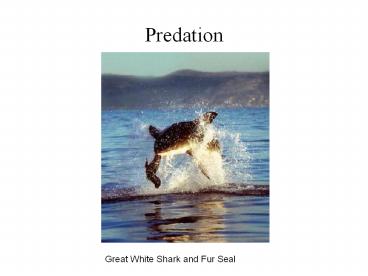Predation - PowerPoint PPT Presentation
1 / 49
Title:
Predation
Description:
... and associated development of the organic rooting media required by some populations. Parasitism and Disease Lyme Disease Cycle in the UK Parasitism Parasitism ... – PowerPoint PPT presentation
Number of Views:89
Avg rating:3.0/5.0
Title: Predation
1
Predation
Great White Shark and Fur Seal
2
Plant defenses are developed at a cost to fitness
when
- 1. Organisms evolve more defenses if they are
exposed to much damage and fewer defenses if cost
of defense is high - 2. More defenses are allocated within an
organism to valuable tissues that are at risk - 3. Defense mechanisms are reduced when enemies
are absent and increased when plants are attacked
- mostly true for chemicals not structures - 4. Defense mechanisms are costly and cannot be
maintained if plants are severely stressed by
environmental factors
3
Pine beetle infestation British Columbia
4
Pine Beetle and Pitch Tube
5
Serengeti Grazing System
6
Serengeti Grazing System
7
Serengeti Grazing System
8
Grazing facilitation
- Grazing facilitation occurs when the feeding
activity of one herbivore species improves the
food supply for a second species
9
Opuntia stricta prickly pear
10
Prickly pear infestation in Australia
11
Area infested with prickly pear before biocontrol
12
Same area after biocontrol
13
Biocontrol Agent Cactoblastis cactorum
14
Symbiosis
15
Symbiosis
- Symbioses - species living in close association
- Parasitism ,- parasite benefits, host harmed
- Commensalism ,0 or 0,0 can have positive effect
for one species or for neither - Mutualism , both species benefit
16
Gopher Tortoise Commensal Host
17
Gopher Tortoise Distribution
18
(No Transcript)
19
Epiphytes
Birds Nest Fern
20
Nalini Nadkarni studying epiphytes
21
Epiphytes
Figure 1 Hypothetical tree illustrating how
vascular epiphytes in humid forests tend to
partition substrates illustrating sensitivity to
micro climate, particularly humidity, and
associated development of the organic rooting
media required by some populations.
22
Parasitism and Disease
Lyme Disease Cycle in the UK
23
Parasitism
- Parasitism - intimate association between two
species in which the parasite obtains its
nutrients from a host - parasite usually causes
some degree of harm to its host - either reduced
growth or reproduction - Pathogen disease causing agent
- Disease abnormal condition of host due to
infection by a pathogen that impairs
physiological functioning
24
Parasites on Plants
25
Insects are green, Fungi are brown, Worms are
blue, Protozoa are yellow
26
Parasitism occurs on a continuum from
- ectoparasites - live outside hosts body and
experience same conditions as host - ticks,
mites, fleas, aphids - endoparasites - live inside host's body cavity -
buffered from outside conditions - tapeworms,
flukes - intracellular parasites - live inside individual
cells of the host - viruses, bacteria, protozoa -
often called microparasites
27
Or another way to divide parasites
- microparasites - viruses, bacteria, protozoa -
small, often live intracellularly, main point is
that they reproduce in host and will have very
large numbers in host - macroparasites - tiny to very large - nematodes,
tapeworms, flukes - larger individuals that grow
in host but multiply by producing infective
stages that are shed by host to environment where
they infect new hosts
28
(No Transcript)
29
Parasite Transmission
- Direct transmission from one host to another of
the same species via air, water, coughing, blood,
feces, etc. - Indirect transmission from one host to another
of the same species via another species called a
vector - Vector species which transmits parasite or
pathogen from one host to another
30
Microparasites Macroparasites
Direct transmission HIV virus, Amoebic dysentery, Mildews on plants Lice, fleas, ticks, aphids, hookworm, pinworm, mistletoe
Indirect transmission Plasmodium (mosquito), Plant viruses (aphids), Trypanosoma (tsetse fly) Tapeworms, Schistosomes (snails), Rust fungi
31
Powdery Mildew on Grape Leaf
32
Powdery Mildew Life Cycle
33
(No Transcript)
34
Head Lice and Life Cycle
35
Mistletoe
36
Mistletoe Life Cycle
37
Malaria disease cycle
38
(No Transcript)
39
Schistosomiasis - Life cycle of the schistosome
worm
40
Worldwide incidence of schistosomiasis
41
Worldwide incidence of schistosomiasis
42
Rust Fungus Canker
43
Rust Fungus Life Cycle
44
Two ways to study parasite numbers
- Prevalence percent of host population that is
infected best for microparasites - Intensity number of parasite individuals per
host usually best for macroparasites
45
Frequency of infection
- Parasites usually occur in aggregated
distributions due to 4 possible factors - 1) random colonization events followed by asexual
reproduction in hosts that do get parasitized - 2) environmental "hot spots" where parasite eggs
and infective stages survive well - 3) dispersal constraints - geographic or
behavioral barriers limit dispersal of parasites
to just a few hosts - 4) variation in susceptibility of individual
hosts - due to nutrition, genetics
46
European rabbits as pests in Australia - 1938
47
Introduced pests in Australia red fox, rabbit,
cat, pig, goat
48
(No Transcript)
49
(No Transcript)

